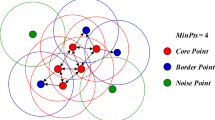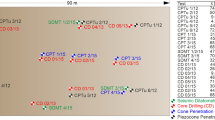Abstract
In the agricultural field, concrete headworks is the most important structure for the irrigation system. In recent years, a number of agricultural concrete infrastructures aging for a long-term period have been increasing. For maintenance and management, conventional inspection methods are time-consuming and costly, such as the electromagnetic wave method and elastic wave method. The detection of surface damage is more effective, safe and reliable than before since the laser scanning method provides detailed geometric information about the structure. The fundamental studies on point cloud data have been conducted in the civil engineering fields; nevertheless, the characteristics of point cloud in agricultural infrastructures, such as dam, headworks and canal, have not been discussed. In this study, 3D point clouds are generated for a concrete irrigation structure using the laser scanning method. The characteristics of surface damage which are quantitatively evaluated using point cloud information, geometric information and intensity parameter are investigated. The types of detected damage are efflorescence and cracks. It is investigated whether point clouds generated from a single scan or multiple scans are more effective for highly accurate detection. The characteristics of surface damage are evaluated by geometric features. The distance between the fitted plane and points is calculated by RANSAC algorithm and roughness parameter. The amount of efflorescence is detected by the distance between the fitted plane from RANSAC algorithm and points. The crack is detected by the local plane fitting method. The types of damage are characterized by the intensity parameter which is related to the color, roughness and moisture of the object. The surface damage and condition are evaluated by both geometric information and intensity parameter. These results show the unique parameters of point clouds from laser scanning methods, such as geometric features and intensity parameter, are useful to evaluate the characteristics of surface damage.












Similar content being viewed by others
References
Chang KT, Chang JR, Liu JK (2005) Detection of pavement distresses using 3D laser scanning technology. Comput Civ Eng. https://doi.org/10.1061/40794(179)103
Che E, Jung J, Olsen MJ (2019) Object recognition, segmentation, and classification of mobile laser scanning point clouds: a state of the art review. Sensors 19(4):810. https://doi.org/10.3390/s19040810
Cloudcompare.org (2022) CloudCompare—Open Source project. https://www.danielgm.net/cc/. Accessed 2 January 2022
Cloudcompare.org (2022) Roughness https://www.cloudcompare.org/doc/wiki/index.php/Roughness. Accessed 2 January 2022
Costantino D, Angelini MG (2013) Qualitative and quantitative evaluation of the luminance of laser scanner radiation for the classification of materials. In: Proceedings of the ISPRS-International archives of the photogrammetry, remote sensing and spatial information sciences, Strasbourg, pp 2–6. https://doi.org/10.5194/isprsarchives-XL-5-W2-207-2013
De Blasiis MR, Di Benedetto A, Fiani M (2020) Mobile laser scanning data for the evaluation of pavement surface distress. Remote Sens 12(6):942. https://doi.org/10.3390/rs12060942
Dimitrov A, Golparvar-Fard M (2015) Segmentation of building point cloud models including detailed architectural/structural features and MEP systems. Autom Constr 51:32–45. https://doi.org/10.1016/j.autcon.2014.12.015
DJI (2022) Next generation mapping—saving time in construction surveying with drones. https://enterprise.dji.com/news/detail/next-generation-mapping. Accessed 10 December 2022
Dong Z, Liang F, Yang B, Xu Y, Zang Y, Li J, Wang Y, Dai W, Fan H, Hyyppä JU (2020) Registration of large-scale terrestrial laser scanner point clouds: a review and benchmark. ISPRS J Photogramm Remote Sens 163:327–342. https://doi.org/10.1016/j.isprsjprs.2020.03.013
Douros I, Buxton BF (2002) Three-dimensional surface curvature estimation using quadric surface patches. University College London. 44. https://www.academia.edu/15844128/Three_Dimensional_Surface_Curvature_Estimation_using_Quadric_Surface_Patches. Accessed 12 January 2024
Dung CV (2019) Autonomous concrete crack detection using deep fully convolutional neural network. Autom Constr 99:52–58. https://doi.org/10.1016/j.autcon.2018.11.028
FARO Technologies (2022) FARO SCENE software website. https://www.faro.com/en/Products/Software/SCENE-Software. Accessed 2 January 2023
Fukuda Y, Feng MQ, Shinozuka M (2010) Cost-effective vision-based system for monitoring dynamic response of civil engineering structures. Struct Control Health Monit 17(8):918–936. https://doi.org/10.1002/stc.360
Gönültaş F, Atık ME, Duran Z (2020) Extraction of roof planes from different point clouds using RANSAC algorithm. Int J Environ Geoinf 7(2):165–171. https://doi.org/10.30897/ijegeo.715510
Grilli E, Menna F, Remondino F (2017) A review of point clouds segmentation and classification algorithms. Int Arch Photogramm Remote Sens Spat Inf Sci 42:339. https://doi.org/10.5194/isprs-archives-XLII-2-W3-339-2017
Guo L, Chehata N, Mallet C, Boukir S (2011) Relevance of airborne lidar and multispectral image data for urban scene classification using random forests. ISPRS J Photogramm Remote Sens 66(1):56–66. https://doi.org/10.1016/j.isprsjprs.2010.08.007
Hackel T, Wegner JD, Schindler K (2017) Joint classification and contour extraction of large 3D point clouds. ISPRS J Photogramm Remote Sens 130:231–245. https://doi.org/10.1016/j.isprsjprs.2017.05.012
Höfle B, Pfeifer N (2007) Correction of laser scanning intensity data: data and model-driven approaches. ISPRS J Photogramm Remote Sens 62(6):415–433. https://doi.org/10.1016/j.isprsjprs.2007.05.008
ISO (2021) Geometrical product specifications (GPS)—surface texture: areal—Part 2: terms, definitions and surface texture parameters. https://www.iso.org/standard/74591.html. Accessed 2 January 2023
ISO (2022) Optics and optical instruments—field procedures for testing geodetic and surveying instruments. https://www.iso.org/obp/ui/#iso:std:iso:17123:-1:ed-3:v1:en. Accessed 2 January 2023
Japan Meteorological Agency (2022) https://www.data.jma.go.jp/obd/stats/etrn/view/daily_s1.php?prec_no=54&block_no=47612&year=2022&month=9&day=8&view. Accessed 2 January 2023. (in Japanese)
Jérôme D, Clément M, Nicolas D, Bruno V (2011) Dimensionality based scale selection in 3D lider point clouds. ISPRS Int Arch Photogramm Remote Sens Spat Inf Sci 38(5):97–102. https://doi.org/10.5194/isprsarchives-XXXVIII-5-W12-97-2011
Jutzi B, Gross H (2009) Normalization of LiDAR intensity data based on range and surface incidence angle. Int Arch Photogramm Remote Sens Spat Inf Sci 38:213–218
Kaartinen E, Dunphy K, Sadhu A (2022) Lidar-based structural health monitoring: applications in civil infrastructure systems. Sensors 22(12):4610. https://doi.org/10.3390/s22124610
Kersten TP, Sternberg H, Mechelke K (2005) Investigations into the accuracy behaviour of the terrestrial laser scanning system Mensi GS100. Proc 3D Opt Meas Tech 1:122–131
Law DW, Silcock D, Holden L (2018) Terrestrial laser scanner assessment of deteriorating concrete structures. Struct Control Health Monit 25(5):e2156. https://doi.org/10.1002/stc.2156
Leader JC (1979) Analysis and prediction of laser scattering from rough-surface materials. JOSA 69(4):610–628. https://doi.org/10.1364/JOSA.69.000610
Lerones PM, Vélez DO, Rojo FG, Gómez-García-Bermejo J, Casanova EZ (2016) Moisture detection in heritage buildings by 3D laser scanning. Stud Conserv 61:46–54. https://doi.org/10.1179/2047058415Y.0000000017
Lichti DD (2007) Error modelling, calibration and analysis of an AM–CW terrestrial laser scanner system. ISPRS J Photogramm Remote Sens 61(5):307–324. https://doi.org/10.1016/j.isprsjprs.2006.10.004
Lichti DD, Jamtsho S (2006) Angular resolution of terrestrial laser scanners. Photogram Rec 21(114):141–160. https://doi.org/10.1111/j.1477-9730.2006.00367.x
Mazalová J, Valentová K, Vlčková L (2010) Testing of accuracy of reflectorless distance measurement of selected Leica and Topcon total stations. GeoSci Eng 56(1):19–26
Mechelke K, Kersten TP, Lindstaedt M (2007) Comparative investigations into the accuracy behaviour of the new generation of terrestrial laser scanning systems. Proc in the Opt 3:19–327
Mill T, Alt A, Liias R (2013) Combined 3D building surveying techniques–terrestrial laser scanning (TLS) and total station surveying for BIM data management purposes. J Civ Eng Manag 19(1):S23–S32. https://doi.org/10.3846/13923730.2013.795187
Moon D, Chung S, Kwon S, Seo J, Shin J (2019) Comparison and utilization of point cloud generated from photogrammetry and laser scanning: 3D world model for smart heavy equipment planning. Autom Constr 98:322–331. https://doi.org/10.1016/j.autcon.2018.07.020
Morozova N, Shibano K, Shimamoto Y, Tayfur S, Alver N, Suzuki T (2022) Visualization and evaluation of concrete damage in-service headworks by X-ray CT and non-destructive inspection methods. Front Built Environ. https://doi.org/10.3389/fbuil.2022.947759
Mutlib NK, Baharom SB, El-Shafie A, Nuawi MZ (2016) Ultrasonic health monitoring in structural engineering: buildings and bridges. Struct Control Health Monit 23(3):409–422. https://doi.org/10.1002/stc.1800
Nicodemus FE (1965) Directional reflectance and emissivity of an opaque surface. Appl Opt 4(7):767–775. https://doi.org/10.1364/AO.4.000767
Pesci A, Teza G (2008) Effects of surface irregularities on intensity data from laser scanning: an experimental approach. Ann Geophys. https://doi.org/10.4401/AG-4462
Pfeifer N, Höfle B, Briese C, Rutzinger M, Haring A (2008) Analysis of the backscattered energy in terrestrial laser scanning data. Int Arch Photogramm Remote Sens Spat Inf Sci 37:1045–1052
Rusu RB, Marton ZC, Blodow N, Dolha M, Beetz M (2008) Towards 3D point cloud based object maps for household environments. Robot Auton Syst 56(11):927–941. https://doi.org/10.1016/j.robot.2008.08.005
Sánchez-Rodríguez A, Riveiro B, Conde B, Soilán M (2018) Detection of structural faults in piers of masonry arch bridges through automated processing of laser scanning data. Struct Control Health Monit 25(3):e2126. https://doi.org/10.1002/stc.2126
Schnabel R, Wahl R, Klein R (2007) Efficient RANSAC for point-cloud shape detection. Comput Graph Forum 26(2):214–226. https://doi.org/10.1111/j.1467-8659.2007.01016.x
Schnabel R, Degener P, Klein R (2009) Completion and reconstruction with primitive shapes. Comput Graph Forum 28(2):503–512. https://doi.org/10.1111/j.1467-8659.2009.01389.x
Shibano K, Morozova N, Hagiwara T, Shimamoto Y, Suzuki T, Chiyoda A, Suematsu K, Tachibana Y, Ito H (2022) Use of infrared thermography for damage detection of concrete structure by machine learning. In: international workshop on advanced experimental mechanics for students and young researches (IWAEM'22)
Shimamoto Y, Hagiwara T, Suzuki T (2020) Identification of efflorescence in reinforced concrete slab of road bridge by decision tree. Irrig Drain Rural Eng J 88(1):59–65. https://doi.org/10.11408/jsidre.88.I_59. (In Japanese)
Soudarissanane S, Lindenbergh R, Menenti M, Teunissen P (2011) Scanning geometry: Influencing factor on the quality of terrestrial laser scanning points. ISPRS J Photogramm Remote Sens 66(4):389–399. https://doi.org/10.1016/j.isprsjprs.2011.01.005
Stałowska P, Suchocki C, Rutkowska M (2022) Crack detection in building walls based on geometric and radiometric point cloud information. Autom Constr 134:104065. https://doi.org/10.1016/j.autcon.2021.104065
Suchocki C (2020) Comparison of time-of-flight and phase-shift TLS intensity data for the diagnostics measurements of buildings. Materials 13(2):353. https://doi.org/10.3390/ma13020353
Suchocki C, Katzer J (2018) Terrestrial laser scanning harnessed for moisture detection in building materials–Problems and limitations. Autom Constr 94:127–134. https://doi.org/10.1016/j.autcon.2018.06.010
Suchocki C, Katzer J, Rapiński J (2018) Terrestrial laser scanner as a tool for assessment of saturation and moisture movement in building materials. Period Polytech Civ Eng 62(3):694–699. https://doi.org/10.3311/PPci.11406
Suzuki T, Nishimura S, Shimamoto Y, Shiotani T, Ohtsu M (2020) Damage estimation of concrete canal due to freeze and thawed effects by acoustic emission and X-ray CT methods. Constr Build Mater 245:118343. https://doi.org/10.1016/j.conbuildmat.2020.118343
Tan K, Cheng X, Ju Q, Wu S (2016) Correction of mobile TLS intensity data for water leakage spots detection in metro tunnels. IEEE Geosci Remote Sens Lett 13(11):1711–1715. https://doi.org/10.1109/LGRS.2016.2605158
Teza G, Galgaro A, Moro F (2009) Contactless recognition of concrete surface damage from laser scanning and curvature computation. NDT E Int 42(4):240–249. https://doi.org/10.1016/j.ndteint.2008.10.009
Voisin S, Foufou S, Truchetet F, Page DL, Abidi MA (2007) Study of ambient light influence for three-dimensional scanners based on structured light. Opt Eng 46(3):030502. https://doi.org/10.1117/1.2717126
Weinmann M (2013) Feature relevance assessment for the semantic interpretation of 3D point cloud data. ISPRS Ann Photogramm Remote Sens Spat Inf Sci 2:313–318
Zhang C, Elaksher A (2012) An unmanned aerial vehicle-based imaging system for 3D measurement of unpaved road surface distresses. Comput Aided Civ Infrastruct Eng 27(2):118–129. https://doi.org/10.1111/j.1467-8667.2011.00727.x
Author information
Authors and Affiliations
Corresponding author
Rights and permissions
Springer Nature or its licensor (e.g. a society or other partner) holds exclusive rights to this article under a publishing agreement with the author(s) or other rightsholder(s); author self-archiving of the accepted manuscript version of this article is solely governed by the terms of such publishing agreement and applicable law.
About this article
Cite this article
Shibano, K., Morozova, N., Ito, Y. et al. Evaluation of surface damage for in-service deteriorated agricultural concrete headworks using 3D point clouds by laser scanning method. Paddy Water Environ 22, 257–269 (2024). https://doi.org/10.1007/s10333-023-00965-3
Received:
Revised:
Accepted:
Published:
Issue Date:
DOI: https://doi.org/10.1007/s10333-023-00965-3




